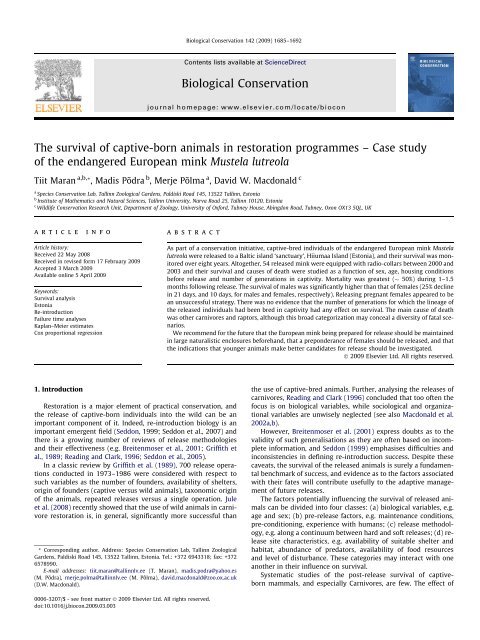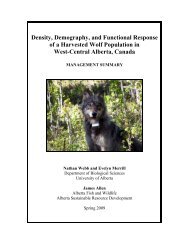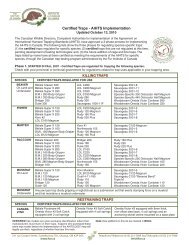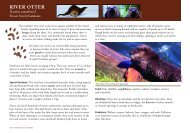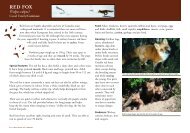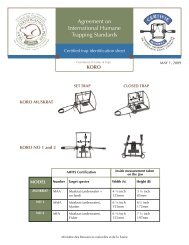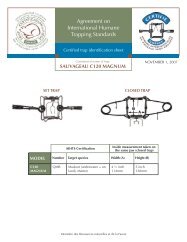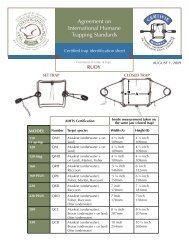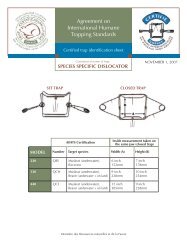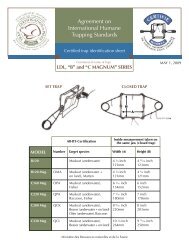Survival Rate of Released Mink Study - Animal Liberation Front
Survival Rate of Released Mink Study - Animal Liberation Front
Survival Rate of Released Mink Study - Animal Liberation Front
You also want an ePaper? Increase the reach of your titles
YUMPU automatically turns print PDFs into web optimized ePapers that Google loves.
Biological Conservation 142 (2009) 1685–1692Contents lists available at ScienceDirectBiological Conservationjournal homepage: www.elsevier.com/locate/bioconThe survival <strong>of</strong> captive-born animals in restoration programmes – Case study<strong>of</strong> the endangered European mink Mustela lutreolaTiit Maran a,b, *, Madis Põdra b , Merje Põlma a , David W. Macdonald ca Species Conservation Lab, Tallinn Zoological Gardens, Paldiski Road 145, 13522 Tallinn, Estoniab Institute <strong>of</strong> Mathematics and Natural Sciences, Tallinn University, Narva Road 25, Tallinn 10120, Estoniac Wildlife Conservation Research Unit, Department <strong>of</strong> Zoology, University <strong>of</strong> Oxford, Tubney House, Abingdon Road, Tubney, Oxon OX13 5QL, UKarticleinfoabstractArticle history:Received 22 May 2008Received in revised form 17 February 2009Accepted 3 March 2009Available online 5 April 2009Keywords:<strong>Survival</strong> analysisEstoniaRe-introductionFailure time analysesKaplan–Meier estimatesCox proportional regressionAs part <strong>of</strong> a conservation initiative, captive-bred individuals <strong>of</strong> the endangered European mink Mustelalutreola were released to a Baltic island ‘sanctuary’, Hiiumaa Island (Estonia), and their survival was monitoredover eight years. Altogether, 54 released mink were equipped with radio-collars between 2000 and2003 and their survival and causes <strong>of</strong> death were studied as a function <strong>of</strong> sex, age, housing conditionsbefore release and number <strong>of</strong> generations in captivity. Mortality was greatest ( 50%) during 1–1.5months following release. The survival <strong>of</strong> males was significantly higher than that <strong>of</strong> females (25% declinein 21 days, and 10 days, for males and females, respectively). Releasing pregnant females appeared to bean unsuccessful strategy. There was no evidence that the number <strong>of</strong> generations for which the lineage <strong>of</strong>the released individuals had been bred in captivity had any effect on survival. The main cause <strong>of</strong> deathwas other carnivores and raptors, although this broad categorization may conceal a diversity <strong>of</strong> fatal scenarios.We recommend for the future that the European mink being prepared for release should be maintainedin large naturalistic enclosures beforehand, that a preponderance <strong>of</strong> females should be released, and thatthe indications that younger animals make better candidates for release should be investigated.Ó 2009 Elsevier Ltd. All rights reserved.1. IntroductionRestoration is a major element <strong>of</strong> practical conservation, andthe release <strong>of</strong> captive-born individuals into the wild can be animportant component <strong>of</strong> it. Indeed, re-introduction biology is animportant emergent field (Seddon, 1999; Seddon et al., 2007) andthere is a growing number <strong>of</strong> reviews <strong>of</strong> release methodologiesand their effectiveness (e.g. Breitenmoser et al., 2001; Griffith etal., 1989; Reading and Clark, 1996; Seddon et al., 2005).In a classic review by Griffith et al. (1989), 700 release operationsconducted in 1973–1986 were considered with respect tosuch variables as the number <strong>of</strong> founders, availability <strong>of</strong> shelters,origin <strong>of</strong> founders (captive versus wild animals), taxonomic origin<strong>of</strong> the animals, repeated releases versus a single operation. Juleet al. (2008) recently showed that the use <strong>of</strong> wild animals in carnivorerestoration is, in general, significantly more successful than* Corresponding author. Address: Species Conservation Lab, Tallinn ZoologicalGardens, Paldiski Road 145, 13522 Tallinn, Estonia. Tel.: +372 6943318; fax: +3726578990.E-mail addresses: tiit.maran@tallinnlv.ee (T. Maran), madis.podra@yahoo.es(M. Põdra), merje.polma@tallinnlv.ee (M. Põlma), david.macdonald@zoo.ox.ac.uk(D.W. Macdonald).the use <strong>of</strong> captive-bred animals. Further, analysing the releases <strong>of</strong>carnivores, Reading and Clark (1996) concluded that too <strong>of</strong>ten thefocus is on biological variables, while sociological and organizationalvariables are unwisely neglected (see also Macdonald et al.2002a,b).However, Breitenmoser et al. (2001) express doubts as to thevalidity <strong>of</strong> such generalisations as they are <strong>of</strong>ten based on incompleteinformation, and Seddon (1999) emphasises difficulties andinconsistencies in defining re-introduction success. Despite thesecaveats, the survival <strong>of</strong> the released animals is surely a fundamentalbenchmark <strong>of</strong> success, and evidence as to the factors associatedwith their fates will contribute usefully to the adaptive management<strong>of</strong> future releases.The factors potentially influencing the survival <strong>of</strong> released animalscan be divided into four classes: (a) biological variables, e.g.age and sex; (b) pre-release factors, e.g. maintenance conditions,pre-conditioning, experience with humans; (c) release methodology,e.g. along a continuum between hard and s<strong>of</strong>t releases; (d) releasesite characteristics, e.g. availability <strong>of</strong> suitable shelter andhabitat, abundance <strong>of</strong> predators, availability <strong>of</strong> food resourcesand level <strong>of</strong> disturbance. These categories may interact with oneanother in their influence on survival.Systematic studies <strong>of</strong> the post-release survival <strong>of</strong> captivebornmammals, and especially Carnivores, are few. The effect <strong>of</strong>0006-3207/$ - see front matter Ó 2009 Elsevier Ltd. All rights reserved.doi:10.1016/j.biocon.2009.03.003
1686 T. Maran et al. / Biological Conservation 142 (2009) 1685–1692pre-release training and housing has been studied on Black-footedferret Mustela nigripes (Biggins et al., 1998a, 1999; Vargas et al.,1998). Swedish studies have shown that translocated wild-born ottersLutra lutra have higher survival than do re-introduced captivebornotters (Sjoasen 1996, 1997). Hellstedt and Kallio (2005) demonstratedexperimentally that the survival <strong>of</strong> released weaselsMustela nivalis improved when young animals were released duringthe periods <strong>of</strong> high food abundance, while Bremner-Harrisonet al. (2004) report that important predictors <strong>of</strong> the survival <strong>of</strong> releasedswift foxes Vulpes velox are the extent <strong>of</strong> their habituation tocaptivity and measures <strong>of</strong> their ‘boldness’.European mink is a slender, small, dark-colored, semi-aquaticmustelid that once inhabited streams and rivers throughout Europe.It inhabits riparian zones along small rivers and streams inforested landscapes and seldom moves further than 100 m fromriverbank (Danilov and Tumanov, 1976). Today the European minkis globally endangered, and critically endangered within the EuropeanUnion (Temple and Terry, 2007). Principal threats to its survivalare habitat loss, over-exploitation and the impact <strong>of</strong> thealien American mink Neovison vison (Maran and Henttonen,1995; Maran et al., 1998; Sidorovich, 2001; Sidorovich and Mac-Donald, 2001). There are no data on the survival <strong>of</strong> captive-bredEuropean mink in the wild. In 2000, as part <strong>of</strong> a programme to conservethe European mink, we initiated an experimental release <strong>of</strong>captive-bred individuals into an island sanctuary, Hiiumaa in theBaltic Sea (Macdonald et al., 2002c; Maran, 2006). This experimentallowed us to test the impact <strong>of</strong> biological and pre-release factorson the survival <strong>of</strong> released individuals.Our wider approach to European mink conservation, and thebackground to the Hiiumaa experiment, is given in Macdonaldet al. (2002c) and in Maran(2003, 2006). In summary, since 2000,European mink bred at a special conservation breeding facility atTallinn Zoological Gardens (Estonia) have been released to the island<strong>of</strong> Hiiumaa. The research aim <strong>of</strong> these releases has been tostudy the factors relevant to establishing island populations <strong>of</strong>the European mink as a means <strong>of</strong> safeguarding them from the negativeimpacts <strong>of</strong> the invasive American mink (Sidorovich et al.,1999).The experiment contrasted the survival outcomes <strong>of</strong> alternativerelease processes, in terms <strong>of</strong> animal selection, their pre-conditioning,while the release methodology and release site selection followedidentical protocols. The release procedure is detailed inMaran (2006). For each released individual we noted the age, sex,number <strong>of</strong> generations in captivity, housing conditions before releaseand pregnancy <strong>of</strong> released females. Radio-tracking data revealedthe causes <strong>of</strong> mortality and facilitated the retrospectiveanalysis <strong>of</strong> survival, the effect <strong>of</strong> the dependent variables on survivaland the dependence <strong>of</strong> survival on these variables.Our study aims to answer the following questions:1. What is the survival rate <strong>of</strong> released mink and how does itchange with time since release?2. Do age, sex <strong>of</strong> an individual, and the conditions in which it iskept prior to release, affect its subsequent survival in the wild?3. What are causes <strong>of</strong> mortality?2. Methods2.1. <strong>Study</strong> areaHiiumaa Island, with an area <strong>of</strong> 1019 km 2 and a coastline <strong>of</strong>326 km, is located in the Baltic Sea in the Atlantic continental region<strong>of</strong> the Temperate Zone (Fig. 1). The climate is characterized by mildwinters (average temperature 3.5– 4.5 °C) and warm summers(+16.5–+17 °C). The annual precipitation ranged in 1961–2002 between400 and 825 (average 625) mm (Põdra and Maran, 2003).The shortest distance to the mainland is 22 km and to other largerislands (Vormsi and Saaremaa) – 9 km and 5 km, respectively.As <strong>of</strong> 2001, the island had a human population <strong>of</strong> 11335 (11.1inhabitants/km 2 ), dispersed between three small towns and 182villages (www.hiiumaa.ee; as <strong>of</strong> 15.02.2009).Fig. 1. Location <strong>of</strong> Hiiumaa Island.
T. Maran et al. / Biological Conservation 142 (2009) 1685–1692 1687Forest covers around 70% <strong>of</strong> the island, and more than 22 naturereserves encompass over 20% <strong>of</strong> the land area (www.eelis.ee; as<strong>of</strong>15.02.2009).2.1.1. FaunaIn addition to the European mink, the mammal fauna <strong>of</strong> the islandincludes eight carnivore species – weasel M. nivalis, stoat Mustelaerminea, pine marten Martes martes, otter L. lutra, raccoon dogNyctereutes procyonoides, red fox Vulpes vulpes, lynx Felis lynx andwolf Canis lupus. There are records <strong>of</strong> earlier occurrence <strong>of</strong> polecatMustela putorius and American mink Neovison vison in the islandbut the American mink was eradicated in 1998–2000 (Macdonaldet al., 2002c). Other semi-aquatic mammals include beaver Castorfiber, northern water vole Arvicola terrestris and water shrew Neomysfodiens. At least eight species <strong>of</strong> small rodents have been recordedin Hiiumaa (Põdra and Maran, 2003).The possible competitors and predators <strong>of</strong> the European minkamong the local raptors are white-tailed eagle Haliaetus albicilla,golden eagle Aquila chrysaetos, eagle owl Bubo bubo, Ural owl Strixuralensis, common buzzard Buteo buteo, northern goshawk Accipitergentilis, northern harrier Circus cyaneus, Montagu’s harrier Circuspygargus and marsh harrier Circus aeruginosus (Põdra and Maran,2003).Amphibians are represented by five species. Common frog Ranatemporaria, moor frog Rana arvalis and common toad Bufo bufo arecommon. Natterjack toad Bufo calamita and common newt Triturusvulgaris are rare. Reptiles are represented by common viper Viperaberus, grass snake Natrix natrix, slow worm Anguis fragilis and commonlizard Lacerta vivipara (Põdra and Maran, 2003).The following fish species have been recorded in the inlandwater bodies <strong>of</strong> Hiiumaa: Esox lucius, Perca fluviatilis, Gymnocephaluscernus, Salmo trutta, Lota lota, Anguilla anguilla, Gasterosteusaculeatus, Pungitius pungitius, Rutilus rutilus, Leuciscus leuciscus, Leuciscusidus, Leucaspius delineatus, Carassius carassius, Tinca tinca,Lamperta fluviatilis. Populations <strong>of</strong> crayfish Astacus astacus exist infour water courses (Põdra and Maran, 2003).2.1.2. Inland water bodiesThere are 40 bigger streams or rivers (with the total length <strong>of</strong>326 km) in the island and 100 km <strong>of</strong> bigger drainage ditchesand 13 lakes with the total length <strong>of</strong> shoreline <strong>of</strong> 25 km (Põdraand Maran, 2003).2.2. Origin <strong>of</strong> released animalsThe released animals were born in captivity at the conservationbreeding facility <strong>of</strong> Tallinn Zoological Gardens, which is coordinatedby the European mink EEP programme (European EndangeredSpecies Program under the European Association <strong>of</strong> Zoosand Aquaria, www.eaza.net). The captive management followsthe European mink EEP captive breeding and husbandry guidelines(unpublished document: accepted by, and lodged with, Europeanmink EEP animal committee in 2005). The founders <strong>of</strong> the EEP captivepopulation originate from Tver, Vologda, Pskov, Novgorod andLeningrad Regions <strong>of</strong> Russia. These regions are considered to beinhabited by one subspecies – M. lutreola novikovi (Heptner et al.,1967) though the validity <strong>of</strong> subspecies for M. lutreola has beenquestioned (Michaux et al., 2005; Youngman, 1982).2.3. Methodology <strong>of</strong> releaseBefore release, the animals were provided an opportunity tocatch the prey they were likely to encounter on the island, andtheir contact with humans (keepers) was reduced to a minimum(human presence was restricted to unavoidable husbandry). Further,the animals were checked for their ability to swim and, asnecessary, ‘coached’ through encouraging the use <strong>of</strong> artificialponds (see Macdonald et al., 2002c for details). Releases followeda hard release protocol – transportation from the breeding facilityto the release area, where individuals were set free in the mostsuitable habitats – that is riverbanks <strong>of</strong> small rivers or canalswith lush riparian vegetation and abundant prey. Transport wasover a distance <strong>of</strong> c. 150 km and lasted some four to five hours,including a 1.5-h ferry trip. The majority <strong>of</strong> the radio-tracked releasedindividuals travelled widely, the survivors settling inestablished home ranges after 1–2 months (Macdonald et al.,2002c).2.4. Radio-trackingFifty-four out <strong>of</strong> the 172 released mink were equipped withradio-collars (Biotrack, UK; Table 1). In open terrain the signalswere detectable at 1 km, and in woodland at 600 m. The lifespan<strong>of</strong> transmitters was around six month and their weight(14 g) constituted 2% <strong>of</strong> male and 3% <strong>of</strong> female weight. The samplesize was reduced due to some transmitter failures and, as iscommonplace in radio-tracking studies <strong>of</strong> mustelines, becausethe thick neck and narrow head <strong>of</strong> the mink resulted in occasionalloss <strong>of</strong> radio-collars (Table 2).The receivers used were TR-4 (Telonics; USA) and R-1000 (CommunicationSpecialist; USA).After the release, the animals’ locations were recorded 1–3times a day during the first week, every day during the next 20days, every two days during the second and third month, and oncea week thereafter. The status <strong>of</strong> the free-living mink was regularlymonitored by spring and autumn live-trapping (Table 2).2.5. <strong>Survival</strong> analysesLive-trapping records revealed that a proportion <strong>of</strong> the releasedanimals survived for up to 39 months. However, for the sake <strong>of</strong>consistency, we included only radio-tracked individuals in theseanalyses, but excluded eight juveniles released exceptionally in autumn(Table 2).Failure time analyses were used to study the survival <strong>of</strong> animalsafter release and the effect <strong>of</strong> co-variables on their survival. Theanimals were divided into groups by variable values (age class,sex, enclosure <strong>of</strong> origin, number <strong>of</strong> generations in captivity, yearTable 1Number <strong>of</strong> released European mink in 2000–2003.Year Number <strong>of</strong> releases With radio-collarsMales Females Total released In summer In autumnNon-pregnantPregnant2000 8 9 0 17 9 8 172001 19 22 0 41 41 0 232002 23 19 12 54 39 15 122003 32 14 14 60 42 18 2Total 82 64 26 172 131 41 54
1688 T. Maran et al. / Biological Conservation 142 (2009) 1685–1692Table 2<strong>Mink</strong> radio-tracked in 2000–2003. Maximum survival time – known from yearly live-trapping census following the release operation. These data are not included in the analysisfor the sake <strong>of</strong> consistency in measuring methods. Average T - Number <strong>of</strong> generations in captivity. Status – <strong>Mink</strong> with the following status were censored: Lost – signal lost; Alive– alive at the end <strong>of</strong> radio-tracking; Collar – radio-collar lost.ID Sex Pregnant Birth date Release date Last recordedsignal<strong>Survival</strong> time(radio-tracking)Maximumsurvival timeEnclosuretypeAge Average T Status686 Female No 09.06.1999 28.06.2000 7.07.2000 9 9 Small 1 1.500 Lost695 Male No 18/06/1999 28.06.2000 29.11.2000 154 196 Small 1 3.125 Alive679 Female No 04/06/1999 29.06.2000 6.08.2000 38 38 Large 1 1.000 Signal failure680 Female No 04.06.1999 29.06.2000 16.07.2000 17 17 Large 1 1.500 Dead682 Male No 27.05.1999 29.06.2000 23.11.2000 147 630 Small 1 1.500 Alive697 Male No 18.06.1999 29.06.2000 3.08.2000 35 35 Large 1 1.500 Lost681 Female No 04.06.1999 30.06.2000 3.12.2000 156 156 Large 1 1.500 Alive685 Female No 09.06.1999 30.06.2000 16.07.2000 16 16 Small 1 2.250 Dead696 Male No 18.06.1999 30.06.2000 14.07.2000 14 14 Small 1 2.125 Collar844 Male No 2.06.2000 12.06.2001 23.06.2001 11 11 Small 1 6.866 Dead876 Female No 8.06.2000 12.06.2001 27.06.2001 15 15 Small 1 7.092 Collar866 Female No 6.06.2000 13.06.2001 23.06.2001 10 10 Small 1 7.092 Dead886 Male No 10.06.2000 13.06.2001 20.06.2001 7 7 Small 1 7.092 Collar867 Female No 6.06.2000 16.06.2001 3.07.2001 17 17 Small 1 7.092 Dead894 Male No 13.06.2000 16.06.2001 4.07.2001 18 650 Small 1 6.866 Lost694 Female No 18.06.1999 17.06.2001 2.07.2001 15 15 Small 2 7.479 Collar842 Male No 29.05.2000 17.06.2001 18.08.2001 62 62 Large 1 6.205 Collar891 Male No 11.06.2000 17.06.2001 25.08.2001 69 69 Large 1 1.875 Lost872 Female No 8.06.2000 18.06.2001 26.06.2001 8 8 Small 1 1.875 Lost897 Female No 13.06.2000 18.06.2001 26.06.2001 8 8 Small 1 2.250 Dead898 Male No 15.06.2000 18.06.2001 20.08.2001 63 1020 Large 1 2.375 Lost677 Female No 7.06.1999 19.06.2001 15.07.2001 26 26 Small 2 2.375 Lost678 Male No 4.06.1999 19.06.2001 4.07.2001 15 15 Large 2 1.500 Lost689 Female No 13.06.1999 19.06.2001 25.06.2001 6 6 Small 2 1.875 Lost887 Female No 10.06.2000 19.06.2001 5.07.2001 16 16 Small 1 1.750 Collar683 Male No 9.06.1999 20.06.2001 25.08.2001 66 146 Small 2 1.750 Alive856 Female No 5.06.2000 20.06.2001 27.06.2001 7 7 Large 1 1.500 Collar772 Male No 7.06.2000 28.06.2001 1.07.2001 3 3 Small 1 3.250 Collar830 Male No 19.05.2000 28.06.2001 19.07.2001 21 21 Small 1 3.250 Collar862 Female No 5.06.2000 28.06.2001 2.07.2001 4 4 Small 1 2.563 Dead868 Male No 7.06.2000 28.06.2001 19.07.2001 21 21 Small 1 2.563 Dead880 Male No 10.06.2000 28.06.2001 25.08.2001 58 198 Small 1 1.500 Alive832 Female Yes 19.05.2000 4.05.2002 5.05.2002 1 1 Small 2 2.250 Dead852 Female Yes 2.06.2000 4.05.2002 9.05.2002 5 5 Small 2 2.250 Collar881 Female Yes 10.06.2000 4.05.2002 9.05.2002 5 5 Small 2 2.500 Dead904 Female Yes 17.05.2001 4.05.2002 11.07.2002 45 45 Small 1 2.250 Collar853 Female Yes 2.06.2000 15.05.2002 22.05.2002 7 7 Small 2 2.125 Dead906 Female Yes 17.05.2001 15.05.2002 27.05.2002 12 12 Small 1 2.250 Lost560 Female No 25.05.1998 27.05.2002 5.06.2002 9 9 Small 2 1.750 Dead592 Female No 9.06.1998 27.05.2002 15.06.2002 19 19 Small 2 1.750 Dead927 Female Yes 2.06.2001 27.05.2002 21.08.2002 86 305 Large 1 1.938 Alive935 Female No 4.06.2001 27.05.2002 4.07.2002 38 38 Small 1 1.500 Dead952 Female No 14.06.2001 27.05.2002 11.06.2002 15 15 Small 1 2.625 Dead1014 Female No 31.05.2001 27.05.2002 2.06.2002 6 6 Small 2 1.750 Dead911 Female Yes 30.05.2001 27.04.2003 5.05.2003 8 8 Large 2 6.376 Dead980 Male No 7.05.2001 27.04.2003 30.04.2003 3 3 Large 2 7.979 Lost<strong>of</strong> release). The priority <strong>of</strong> this project was the successful release <strong>of</strong>valuable specimens <strong>of</strong> the rare European mink, and <strong>of</strong> their welfare.This led to some constraints on the experimental design,and we are alert to the resulting partial lack <strong>of</strong> orthogonality betweenvariables. Although this reduces the power <strong>of</strong> our final conclusions,we make this explicit and believe that our findingsnonetheless add significantly to the scientific basis for future releases<strong>of</strong> this, and similar, species.Kaplan–Meier survival analysis was used (Muenchow, 1986;Pollock et al., 1989a, 1989b; Scheiner and Gurevitch, 2001) to analysethe overall survival curve and the effect <strong>of</strong> sex and housing onsurvival.The multivariate Cox proportional hazard regression (Muenchow,1986; Scheiner and Gurevitch, 2001; StatS<strong>of</strong>t, 2007) was appliedto identify the model best fitting our data. The general modelwas reduced stepwise, following the Akaike’s Information Criterion(AIC) and Schwarz’s Bayesian Information Criterion (Schwarz’s BIC;Burnham and Anderson, 2002). To reduce the effect <strong>of</strong> correlationbetween variables the data subsets with eliminated correlatingvariable were used.Two data subsets were used for modelling:1. Yearlings within 2000–2001(N = 27). The main purpose <strong>of</strong> themodel was to test the impact <strong>of</strong> yearly variation on survival.2. Yearlings and adults in 2000–2003 excluding pregnant females(N = 38).Kaplan–Meier survival analysis was applied to three datasets:3. Yearlings and adults <strong>of</strong> both sexes released in 2000–2003 fromstandard enclosures (N = 28). This dataset eliminated any effect<strong>of</strong> different housing conditions, and provided an opportunity todistinguish the survival <strong>of</strong> different sexes. Pregnant femaleswere excluded.4. Datasets <strong>of</strong> males (N = 17) and females (N = 21) released in2000–2003. These datasets were used to test the effect <strong>of</strong> housingconditions while controlling for any effect <strong>of</strong> sex. Pregnantfemales were excluded.5. Females, both pregnant and non-pregnant, released from standardenclosures in 2002 (N = 11). This dataset was used to testfor any effect <strong>of</strong> pregnancy.
T. Maran et al. / Biological Conservation 142 (2009) 1685–1692 1689The Systat v 12 for Windows (Systat, 2007) was used to analysethe survival distribution and to model our data with Cox proportionalhazard regression.2.6. Co-variables measured (Table 2)2.6.1. Average number <strong>of</strong> generations in captivityThe number <strong>of</strong> generations in captivity depends upon thelength <strong>of</strong> pedigree lineages <strong>of</strong> all the ancestors <strong>of</strong> a given individual.The number <strong>of</strong> generations in captivity is therefore best characterizedby the average length <strong>of</strong> all these ancestral lineages.These values were calculated with SPARKS v1.55 s<strong>of</strong>tware (ISIS,2007). The animals were divided into two groups: an average <strong>of</strong>3 generations in captivity (n = 12). Data for pregnantfemales were omitted.2.6.2. Housing conditions before releaseThe animals were kept in enclosures <strong>of</strong> two types (data for pregnantfemales omitted):1. Small enclosures: twenty 2 4 m enclosures located in tworows separated by a service corridor. The enclosures were furnishedwith a few stumps and pipes for environmental enrichment.Each enclosure included one pool 30 50 cm in area and25 cm in depth. Adjacent enclosures were separated with doublewelded wire above a 50 cm tall plywood partition at theground level. The animals were fed and the enclosures cleaneddaily. A total <strong>of</strong> 28 individuals was released from theseenclosures.2. Large enclosures: four 25–50 m 2 pre-conditioning enclosuresconstructed <strong>of</strong> welded wire net encompassing natural areaswith trees, bushes and stumps. Each enclosure includes a naturalisticpond (approximate area 1.5 1.5–2.5 2.5 m anddepth 1 m). Contact with keepers was minimal. A total <strong>of</strong> 10individuals was released from these enclosures.3. Results3.1. Overall survivalMost mortality was recorded during the first 30 days followingrelease (Fig. 2). The mean survival time was 54 days and 25% <strong>of</strong> themortality occurred during the first 16 days (95% Conf. Lower – 10days; 95% Conf. Upper – 22 days).3.2. Cox proportional hazard analysis3.2.1. Dataset 1. Yearlings within 2000–2001 (N = 27)According to the Cox proportional hazard regression analysis(Statistic = 11.391; df = 4; P = 0.023), at least one <strong>of</strong> the candidatedependent variables was significantly related to survival (generalmodel in Table 3). There is no evidence <strong>of</strong> an effect <strong>of</strong> history incaptivity or <strong>of</strong> a year <strong>of</strong> release. According to this general model,sex has a strong and significant effect. The reduced model confirmthe effect <strong>of</strong> sex on survival (Statistic = 9.755; df = 2; P = 0.008; Table4). The omission <strong>of</strong> the year and the generations from this modelimproved its fit to our data.3.2.2. Dataset 2. Yearlings and adults in 2000–2003. (N = 38)Considering that fitting the model to dataset 1 had shown thatinter-annual differences did not explain significant variation, weexpanded the dataset with results from 2002/2003 and repeatedthe model fitting exercise. The results were similar. The generalmodel showed that at least one <strong>of</strong> the variables had significant10080<strong>Survival</strong> curveConf.int. 95%2.6.3. Age classesThe released animals were divided into two age classes (pregnantfemales excluded):1. Yearlings: animals released during the second warm seasonafter birth (n = 29).2. Adults: animals released later than the second warm seasonafter birth (n = 9).2.6.4. SexTwenty-one females and 17 males were included in the CoxProportional Hazard Regression (having excluded pregnantfemales).2.6.5. Pregnant femalesOnly females released from standard enclosures in 2002were included in testing the effect <strong>of</strong> pregnancy (N = 11). Six <strong>of</strong>these were pregnant and released during their third week <strong>of</strong>pregnancy.2.6.6. Year <strong>of</strong> releaseThe impact <strong>of</strong> years to survival was tested in two datasets: (a)release <strong>of</strong> yearlings in 2000–2001 (N = 27) and an expanded datasetfrom 2000–2003 (N = 38).2.7. Causes <strong>of</strong> mortalityField signs were used to ascertain, as far as possible, the causes<strong>of</strong> death <strong>of</strong> radio-tracked mink.<strong>Survival</strong> (%)60402000 20 40 60 80 100Time (Days)Fig. 2. Overall cumulative survival curve <strong>of</strong> released European mink (N = 38).Table 3General model for Dataset 1 <strong>of</strong> yearlings in 2000–2001 (N = 27). Cox proportionalhazard regression analysis (the value <strong>of</strong> estimate means the covariate increases thehazard, that is – decreases the survival; AIC = 42.218; Schwarz’s BIC = 42.536).Estimate Standard error Z P-valueSex 2.406 1.023 2.351 0.019Year 0.628 1.040 0.604 0.546Housing 1.983 1.331 1.490 0.136No <strong>of</strong> generations 0.299 0.931 0.321 0.748.
1690 T. Maran et al. / Biological Conservation 142 (2009) 1685–1692Table 4Reduced model for Dataset 1 <strong>of</strong> yearlings in 2000–2001 (N = 27). Cox proportionalhazard regression analysis (the value <strong>of</strong> estimate means the covariate increases thehazard, that is - decreases the survival; AIC = 38.605; Schwarz’s BIC = 38.764).Estimate Standard Error Z P-valueSex 2.323 0.954 2,434 0.015Housing 2.262 1.163 1,945 0.05210080FemalesMalesTable 5General model for Dataset 2 <strong>of</strong> yearlings and adults in 2000–2003 (N = 38). Coxproportional hazard regression analysis (the value <strong>of</strong> estimate means the covariateincreases the hazard, that is – decreases the survival; AIC = 74.813; Schwarz’sBIC = 77.638).Estimate Standard error Z P-valueSex 1.874 0.837 2.239 0.025Year 0.367 0.515 0.713 0.476Housing 1.505 1.229 1.225 0.221Age 0.475 0.689 0.690 0.490No <strong>of</strong> generations 0.065 0.137 0.478 0.633<strong>Survival</strong> (%)60402000 20 40 60 80 100Time (Days)Table 6Reduced model for Dataset 2 <strong>of</strong> yearlings and adults in 2000–2003 (N = 38). Coxproportional hazard regression analysis (the value <strong>of</strong> estimate means the covariateincreases the hazard, that is – decreases the survival; AIC = 56.911; Schwarz’sBIC = 58.041).Estimate Standard error Z P-valueSex 2.050 0.800 2.563 0.010Housing 2.029 1.071 1.894 0.058effect to survival (Statistic = 15.642; df = 5; P = 0.008; Table 5), butthere was no significant impact <strong>of</strong> history in captivity, age, housingor the year <strong>of</strong> release. These variables were omitted from the modelin a stepwise manner. The reduced model incorporates only twovariables, sex and housing, and is stratified by age (Statistic= 11.724; df = 2; P = 0.003; Table 6). The impact <strong>of</strong> sex is clearlysignificant and that <strong>of</strong> housing nearly so. There was no significantdifference between two age strata (yearlings and adults; Manteltest, Statistic = 0.212; df = 1; P = 0.644).3.3. <strong>Survival</strong> <strong>of</strong> females and males (Dataset 3)The survival <strong>of</strong> males was significantly higher than that <strong>of</strong> females(Statistic = 6.973; df = 1; P = 0.008; Fig. 3). Male survival ratefell by 25% over 21 days, while the female survival rate reached thispoint over 10 days. The median survival time for females was 17days and declined to a plateau <strong>of</strong> 25% in 38 days. The fall in malesurvival was slower and then declined to a plateau <strong>of</strong> 74%.3.4. <strong>Survival</strong> <strong>of</strong> animals depending upon pre-release housingconditions (Dataset 4)Our data were insufficient to detect difference in survival <strong>of</strong>males released from different enclosures (N = 16; Statistic = 1.221;df = 1; P = 0.269). Although, there are indication that females releasedfrom large enclosures survived better, the data are insufficientto confirm this (N = 21; Statistic = 3.021; df = 1; P = 0.082).3.5. <strong>Survival</strong> <strong>of</strong> pregnant and non-pregnant females (Dataset 5)There were no significant differences in survival <strong>of</strong> pregnantand non-pregnant females (Statistic = 0.038; df = 1; P = 0.864).Fig. 3. <strong>Survival</strong> curves for males (N = 11) and females (N = 17) released fromstandard enclosures in 2000–2003.In three cases, the litters produced by females released whenpregnant could be monitored. In each case the litter disappearedat about 1.5–2 months <strong>of</strong> age, and the mothers were recorded alivemore than a year later.3.6. Causes <strong>of</strong> deathThe majority <strong>of</strong> attributable causes <strong>of</strong> death were due to othercarnivores (59%; Fig. 4), most <strong>of</strong> them due to red fox V. vulpesand domestic dog.Four deaths, all females, were attributed to raptors, probablygoshawks, A. gentilis, or Ural owl, S. uralensis. We observed threeGoshawk attacks on mink held in enclosures in Hiiumaa Island(Maran & Põdra, unpublished).Three deaths were caused by humans: one was shot, the secondwas hit by a car and the third was beaten to death when venturinginto a farmyard.4. DiscussionA quarter <strong>of</strong> the released European mink died within the firstten days. <strong>Survival</strong> decreased by half in 38 days and then stabilised.This is in line with Macdonald et al. (2002c) who analysed an earliersub-sample <strong>of</strong> the first five released mink (released in 2000)and reported that they established stable home ranges in 25–72days (median = 31, mean = 41.2). Overall, we conclude that minkadapt to the wild c. 1–1.5 months after release.4.1. Challenges in retrospect analysis <strong>of</strong> re-introduction dataOur retrospective analyses were constrained by the priorities <strong>of</strong>the re-introduction programme. Nonetheless, they provide themost substantial scientific basis yet for planning the restoration<strong>of</strong> this highly imperilled mustelid, and also provide a basis for planningfurther experimental releases in the quest for definitiveanalyses.4.2. The effect <strong>of</strong> recorded co-variables on the survival curve<strong>Survival</strong> varied between males and females, but we could detectno effect <strong>of</strong> age. Although no effect <strong>of</strong> year could be detected, its
T. Maran et al. / Biological Conservation 142 (2009) 1685–1692 1691Fig. 4. Causes <strong>of</strong> death (N = 22).interaction with other factors means that it cannot be fullydisregarded.Although our study represents the largest attempt to reintroduceEuropean mink, the data were nonetheless too few to demonstratemore than indicative effects <strong>of</strong> housing conditions. However,these indications clearly deserve further investigation. The importance<strong>of</strong> pre-release housing conditions has been demonstrated bythe black-footed ferret M. nigripes release operation (Biggins et al.,1998a; Vargas and Anderson, 1999; Vargas et al., 1998).The survival <strong>of</strong> mink did not seem to be affected by the number<strong>of</strong> generations their ancestors had spent in captivity. Pre-releasefactors, which shape the behavioural capability <strong>of</strong> mink after release,matter more.The results show that genetically managed, long-term breedingprograms within the zoo community can be a source <strong>of</strong> individualsfor re-introductions (WAZA, 2005).The sex difference in survival might be a consequence <strong>of</strong> sexualdimorphism. Female European mink are about 60% the weight <strong>of</strong>males (Danilov and Tumanov, 1976). This might provide maleswith an advantage in finding food and avoiding predators, but similardifferences between male and female survival have been reportedfor species without sexual dimorphism, such as swift foxV. velox in Canada (Moehrenschlager and Macdonald, 2003). Interestingly,<strong>of</strong> all the fatalities recorded in our study, the victims <strong>of</strong>raptors were always females.The release <strong>of</strong> pregnant females is controversial. If successful itcould lead to rapid bolstering <strong>of</strong> the population. On the other hand,if survival <strong>of</strong> pregnant females was low, it could diminish the efficiency<strong>of</strong> release operations and raise ethical concerns. Our datafail to show a significant difference between the survival <strong>of</strong> pregnantand non-pregnant females after one year, or within a singleyear.The disappearance <strong>of</strong> litters approximately two months postpartum suggests failure to reach independence (during a periodwhen the energetic demand on lactating mammals is known to increase).As lactation progresses the energetic drain on femalemammals increases to 4–7 times above the basal metabolic rate(Allen and Ullrey, 2004).Although our data were too few to reveal any impact <strong>of</strong> age onsurvival, the short reproductive lifespan <strong>of</strong> females – only 3–4 seasons(T. Maran, unpublished) – underlines the likelihood that usingmostly younger females for release is prudent.4.3. Causes <strong>of</strong> deathPredators caused a large proportion (75%) <strong>of</strong> all the recordeddeaths. During the adaptation period the released European minkundertook extensive movements, <strong>of</strong>ten through unsuitable habitats(Macdonald et al. 2002c). The associated strains may be debilitating,increasing susceptibility to predation. Consequently,although predators are the proximate cause <strong>of</strong> death, the ultimatecauses may be a syndrome <strong>of</strong> mal-adaptations.5. Conclusions and recommendationsRe-introduction <strong>of</strong> mammalian predators is an important andchallenging component <strong>of</strong> re-introduction biology, where limitedsample sizes and practicalities <strong>of</strong>ten thwart systematic analyses.Although our analyses were to some extent constrained by theseproblems, our data nonetheless provide the fullest opportunity tostudy the re-introduction <strong>of</strong> European mink to date. Furthermore,they reveal several statistically significant affects on survival.These are the basis for the following conclusions and recommendationsfor future releases <strong>of</strong> European mink (and may plausibly berelevant to other species too):1. The first 1–1.5 months after release – the months with the highestmortality – are critical for a release operation. Any actionsplanned to support the survival <strong>of</strong> released individuals shouldfocus on this period.2. The higher mortality <strong>of</strong> females should be compensated byreleasing a greater proportion <strong>of</strong> them.3. The release <strong>of</strong> pregnant females is not a successful strategy.4. Housing <strong>of</strong> animals in enclosures with a natural interior is sufficientlylikely to contribute to post-release survival that prudencefavours this approach.5. The number <strong>of</strong> generation in captivity contributes less to survivalthan the preparation <strong>of</strong> animals for release and biologicalparameters <strong>of</strong> the individuals.
1692 T. Maran et al. / Biological Conservation 142 (2009) 1685–1692Finally, although this analysis considers critically important impacts<strong>of</strong> biological factors, and aspects <strong>of</strong> pre-release managementon survival, it is noteworthy that no single prescription for releaseis likely to suit all circumstances – a wide array <strong>of</strong> considerationwill always affect project planning.AcknowledgementsThe release operation in Hiiumaa was financially supported bythe UK government’s Darwin Initiative, EU LIFE Project No.LIFE2000NAT/EE/7081, Foundation LUTREOLA, Zoos Help Foundation,Bernhandine Foundation, Denver Zoological Society, ThoiryZoological Park, Apenheul Primate Park, Helsinki Zoo and ZoologicalSociety for Conservation <strong>of</strong> Species and Populations. The projectwas supported by Tallinn Zoo, Rotterdam Zoo and Hiiumaa CountyDepartment <strong>of</strong> the Estonian Ministry <strong>of</strong> the Environment. Fieldworkwas assisted by A. Kranz, S. Hirst, T. Churher, T. Samad, D. Randalland P. Phillpot. Special thanks to Dr. P. Johnson for statistical adviceand to two anonymous reviewers for helpful comments.ReferencesAllen, M.E., Ullrey, D.E., 2004. Relationships among nutrition and reproduction andrelevance for wild animals. Zoo Biology 23, 475–487.Biggins, D.E., Godbey, J.L., Hanebury, L.R., Luce, B., Marinari, P.E., Matchett, M.R.,Vargas, A., 1998. The effect <strong>of</strong> rearing methods on survival <strong>of</strong> reintroducedblack-footed ferrets. Journal <strong>of</strong> Wildlife Management 62, 643–653.Biggins, D.E., Vargas, A., Godbey, J.L., Anderson, S.H., 1999. Influence <strong>of</strong> prereleaseexperience on reintroduced black-footed ferrets (Mustela nigripes). BiologicalConservation 89, 121–129.Breitenmoser, U., Breitenmoser-Würsten, C., Carbyn, L.N., Funk, S.M., 2001.Assessment <strong>of</strong> carnivore introductions. In: Gittleman, J.L., Funk, S.M., Wayne,R.K. (Eds.), Carnivore Conservation. Cambridge University Press, Cambridge.Bremner-Harrison, S., Prodohl, P.A., Elwood, R.W., 2004. Behavioural traitassessment as a release criterion: boldness predicts early death in areintroduction programme <strong>of</strong> captive-bred swift fox (Vulpes velox). <strong>Animal</strong>Conservation 7, 313–320.Burnham, K.P., Anderson, D.R., 2002. Model Selection and Multimodel Inference: APractical Information–theoretic Approach. Springer-Verlag, New York.Danilov, P.I., Tumanov, I.L., 1976. The ecology <strong>of</strong> the European and American minkin the Northwest <strong>of</strong> the USSR. In: Ecology <strong>of</strong> Birds and Mammals in Northwest<strong>of</strong> the USSR. Akad. Nauk. Karelski filial, Inst. Biol. pp. 118–143.Griffith, B., Scott, J.M., Carpenter, J.W., Reed, C., 1989. Translocation as speciesconservation tool: status and strategy. Science 245, 477–480.Hellstedt, P., Kallio, E.R., 2005. <strong>Survival</strong> and behaviour <strong>of</strong> captive-born weasels(Mustela nivalis nivalis) released in nature. Journal <strong>of</strong> Zoology 266, 37–44.Heptner, V.G., Naumov, N.P., Yurgenson, P.B., Sludsky, A.A., Chirkova, A.F., Bannikov,A.G., 1967. Mammals <strong>of</strong> the USSR, Part 2. vol.1, Moscow.ISIS, 2007. SPARKS 1.55: Single Population Analysis and Record Keeping System.MN, International Species Information System (ISIS). Eagan.Jule, K.R., Leaver, L.A., Lea, E.G.L., 2008. The effects <strong>of</strong> captive experience onreintroduction survival in carnivores: A review and analysis. BiologicalConservation 141, 355–363.Macdonald, D.W., Moorhouse, T.P., Enck, J.W., Tattersall, F.H., 2002a. Mammals. In:Perrow, M.R., Davy, A.J. (Eds.), Handbook <strong>of</strong> Ecological Restoration. CambridgeUniversity Press, pp. 389–408.Macdonald, D.W., Moorhouse, T.P., Enck, J.W., Tattersall, F.H., 2002b. The ecologicalcontext: a species population perspective. In: Perrow, M.R., Davy, A.J. (Eds.),Handbook <strong>of</strong> Ecological Restoration. Cambridge University Press, pp. 47–65.Macdonald, D.W., Sidorovich, V.E., Maran, T., Kruuk, H., 2002c. The DarwinInitiative. European <strong>Mink</strong>, Mustela Lutreola: Analyses for Conservation.Wildlife Conservation Research Unit, University <strong>of</strong> Oxford, Oxford.Maran, T., 2003. European mink: setting <strong>of</strong> goal for conservation and Estonian casestudy. Galemys 15, 1–11.Maran, T., 2006. Conservation <strong>of</strong> the European mink in Estonia: an update 2001–2003. In: International Conference on the Conservation <strong>of</strong> European <strong>Mink</strong>(Mustela lutreola). pp. 131–142, Logrono.Maran, T., Henttonen, H., 1995. Why is the European mink (Mustela lutreola)disappearing? – A review <strong>of</strong> the process and hypotheses. Annales ZoologiciFennici 32, 47–54.Maran, T., MacDonald, D.W., Kruuk, H., Sidorovich, V., Rozhnov, V.V., 1998. Thecontinuing decline <strong>of</strong> the European mink, Mustela lutreola: evidence for theintraguild aggression hypothesis. In: Behaviour and Ecology <strong>of</strong> RiparianMammals. Cambridge. pp. 297–324.Michaux, J.R., Libois, R., Hardy, O.J., Justy, F., Fournier, P., Kranz, A., Cabria, M.,Davison, A., Rosoux, R., 2005. Conservation genetics and population history <strong>of</strong>the threatened European mink Mustela lutreola, with an emphasis on the westEuropean population. Molecular Ecology 14, 2373–2388.Moehrenschlager, A., Macdonald, D.W., 2003. Movement and survival parameters <strong>of</strong>translocated and resident swift foxes Vulpes velox. <strong>Animal</strong> Conservation 6, 199–206.Muenchow, G., 1986. Ecological use <strong>of</strong> failure time analysis. Ecology 67, 246–250.Põdra, M., Maran, T., 2003. Management plan <strong>of</strong> the European mink, Mustelalutreola, in Hiiumaa (2004–2008). Foundation Lutreola, Kärdla-Tallinn. pp. 109.Pollock, K.H., Wintersein, S.R., Bunk, C.M., Curtis, P.D., 1989a. <strong>Survival</strong> analysis intelemetry studies: the staggered entry desing. Journal <strong>of</strong> Wildlife Management53, 7–15.Pollock, K.H., Wintersein, S.R., Conroy, M.J., 1989b. Estimation and analysis <strong>of</strong>survival distributions for radio-tagged animals. Biometrics 45, 99–109.Reading, P.R., Clark, T.W., 1996. Carnivore introductions: an interdisciplinaryExamination. In: Carnivore Behavior, Ecology and Evolution. CornellUniversity Press, Ithaca and London, pp. 296–336.Scheiner, M., Gurevitch, J.E., 2001. Design and Analysis <strong>of</strong> Ecological Experiments.Oxford University Press.Seddon, P.J., 1999. Persistence without intervention: assessing success in wildlifereintroductions. Trends in Ecology and Evolution 14, 503.Seddon, P.J., Soorae, P.S., Launay, F., 2005. Taxonomic bias in reintroduction projects.<strong>Animal</strong> Conservation 8, 51–58.Seddon, P.J., Armstrong, D.P., Maloney, R.F., 2007. Developing the science <strong>of</strong>reintroduction biology. Conservation Biology 21, 303–312.Sidorovich, V., 2001. <strong>Study</strong> on the decline in the European mink Mustela lutreolapopulation in connection with the American mink M. vison expansion inBelarus: story <strong>of</strong> the study, review <strong>of</strong> the results and research priorities.Säugetierkundliche Informationen 5, 133–154.Sidorovich, V., MacDonald, D.W., 2001. Density dynamics and changes in habitatuse by the European mink and other native mustelids in connection with theAmerican mink expansion in Belarus. Netherlands Journal <strong>of</strong> Zoology 51, 107–126.Sidorovich, V.E., Kruuk, H., Macdonald, D.W., 1999. Body size, and interactionsbetween European and American mink (Mustela lutreola and M. vison) in EasternEurope. Journal <strong>of</strong> Zoology 248, 521–527.Sjoasen, T., 1996. Survivorship <strong>of</strong> captive-bred and wild-caught reintroducedEuropean otters Lutra lutra in Sweden. Biological Conservation 76, 161–165.Sjoasen, T., 1997. Movements and establishment <strong>of</strong> reintroduced European ottersLutra lutra. Journal <strong>of</strong> Applied Ecology 34, 1070–1080.StatS<strong>of</strong>t, I., 2007. Electronic Statistics Textbook. StatS<strong>of</strong>t, Tulsa, OK.Systat, 2007. Systat 12 For Windows.Temple, H., Terry, A.C., 2007. The Status and Distribution <strong>of</strong> European Mammals.Office for Official Publications <strong>of</strong> the European Communities, Luxembourg.Vargas, A., Anderson, S.H., 1999. Effects <strong>of</strong> experience and cage enrichment onpredatory skills <strong>of</strong> black-footed ferrets (Mustela nigripes). Journal <strong>of</strong>Mammalogy 80, 263–269.Vargas, A., Lockhart, M., Marinari, P., Gober, P., 1998. Preparing captive-raised blackfootedferrets Mustela nigripes for survival after release. Dodo-Journal <strong>of</strong> theWildlife Preservation Trusts 34, 76–83.WAZA, 2005. Building a Future for Wildlife – The World Zoo and AquariumConservation Strategy, Bern.Youngman, P.M., 1982. Distribution and systematics <strong>of</strong> the European mink Mustelalutreola Linnaeus 1761. Acta Zoologica Fennica 166, 48.


